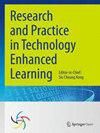Integrating self-explanation and operational data for impasse detection in mathematical learning
IF 3.1
Q1 EDUCATION & EDUCATIONAL RESEARCH
Research and Practice in Technology Enhanced Learning
Pub Date : 2024-07-23
DOI:10.58459/rptel.2025.20019
引用次数: 0
Abstract
Self-explanation is increasingly recognized as a key factor in learning. Identifying learning impasses, which are significant educational challenges, is also crucial as they can lead to deeper learning experiences. This paper argues that integrating self-explanation with relevant datasets is essential for detecting learning impasses in online mathematics education. To test this idea, we created an evaluative framework using a rubric-based approach tailored for mathematical problem-solving. Our analysis combines various data types, including handwritten responses and digital self-explanations from 93 middle school students. Using hierarchical logistic regression, we examined feature groups such as Self-Explanation Quality, Handwriting Features, and Overall Level of Action. Models based solely on self-explanation achieved a 74.0% accuracy rate, while adding more features increased the final model’s accuracy to 80.06%. This improvement highlights the effectiveness of an integrated approach. The combined model, which merges generated handwriting features counts with self-explanation features, shows the importance of both qualitative and quantitative measures in identifying learning impasses. Our findings suggest that a comprehensive approach, leveraging detailed operational data and rich self-explanation content, can enhance the detection of learning challenges, providing insights for personalized education in online learning environments.整合自我解释和操作数据,检测数学学习中的僵局
人们日益认识到,自我解释是学习的一个关键因素。识别学习障碍也是至关重要的,因为学习障碍是重大的教育挑战,可以带来更深刻的学习体验。本文认为,将自我解释与相关数据集结合起来,对于检测在线数学教育中的学习障碍至关重要。为了验证这一观点,我们创建了一个评估框架,采用基于评分标准的方法,专为数学问题解决量身定制。我们的分析结合了各种数据类型,包括来自 93 名中学生的手写回答和数字自我解释。通过分层逻辑回归,我们考察了自我解释质量、手写特征和整体行动水平等特征组。仅基于自我解释的模型准确率为 74.0%,而添加更多特征后,最终模型的准确率提高到 80.06%。这一改进凸显了综合方法的有效性。综合模型将生成的笔迹特征计数与自我解释特征合并在一起,显示了定性和定量测量在识别学习障碍方面的重要性。我们的研究结果表明,利用详细的操作数据和丰富的自我解释内容的综合方法可以增强对学习障碍的检测,为在线学习环境中的个性化教育提供见解。
本文章由计算机程序翻译,如有差异,请以英文原文为准。
求助全文
约1分钟内获得全文
求助全文
来源期刊

Research and Practice in Technology Enhanced Learning
Social Sciences-Education
CiteScore
7.10
自引率
3.10%
发文量
28
审稿时长
13 weeks
文献相关原料
| 公司名称 | 产品信息 | 采购帮参考价格 |
|---|
 求助内容:
求助内容: 应助结果提醒方式:
应助结果提醒方式:


